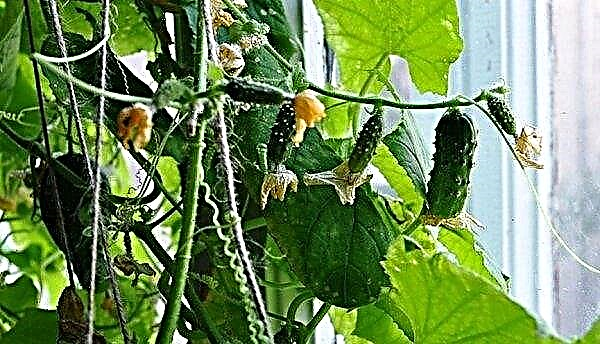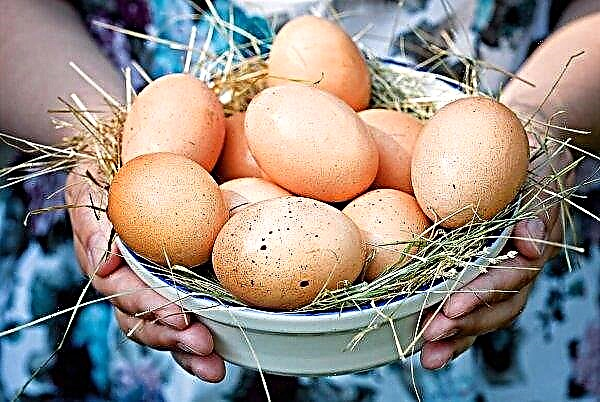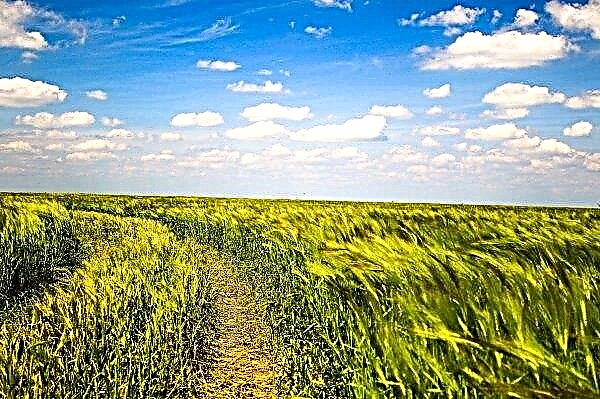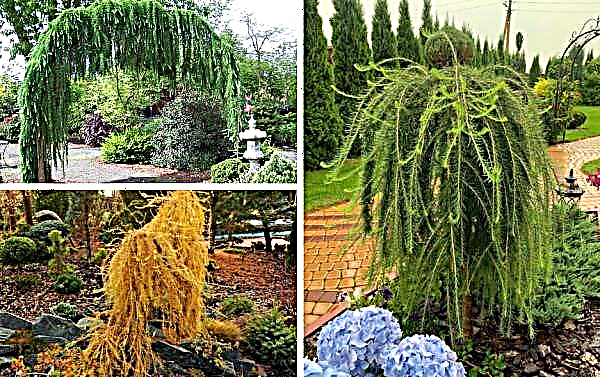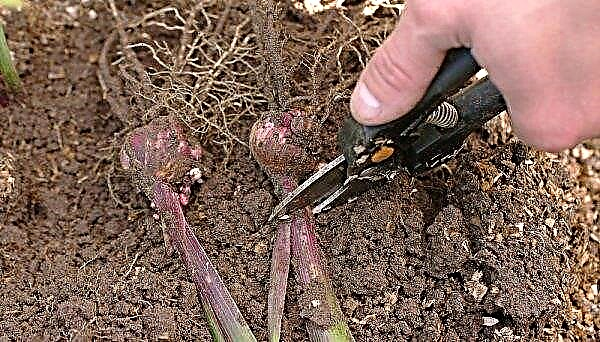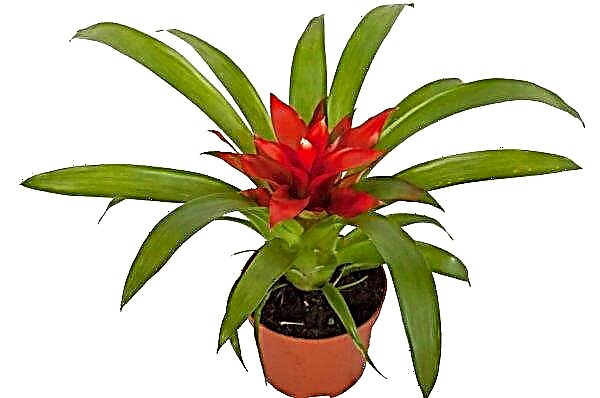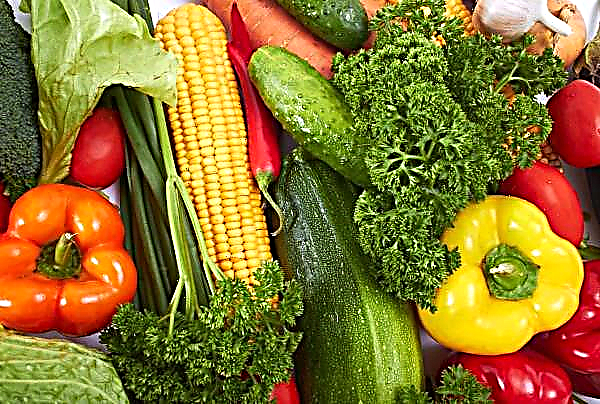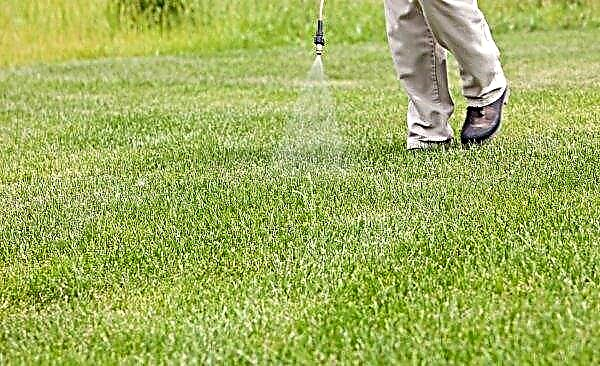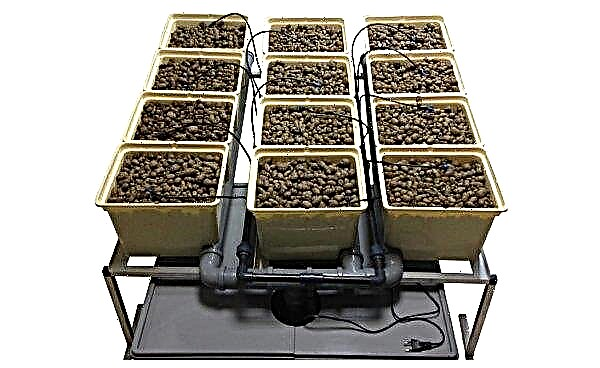Breeders are breeding more and more new varieties of potatoes. It is difficult for the gardener to keep track of all the novelties of this breeding work. In this regard, the proposed material will tell you about the Bullfinch potato variety - a good option for planting in a summer cottage or garden.
Characterization and description of the variety
Variety Snegir is the result of joint breeding work of specialists of the Leningrad Scientific Research Institute of Agriculture "Belogorka" and the Institute of General Genetics named after N. I. Vavilova. In 2001, the variety was registered in the State Register of the Russian Federation.
Did you know? Potatoes activate the brain and resist stress.
The variety is characterized by the following indicators:
- Early table variety, ripening period - 45-50 days.
- Average yield - from one hectare of planting, you can collect from 180 to 270 centners of vegetable.
- High durability.
- Good resistance to most fungal ailments.
- The bush forms up to 15 root crops.
- High palatability. Culinary best suited for soups, salads, as well as for frying.

For a tuber are characteristic:
- Oval shape, small size and light weight - from 50 to 90 g.
- The skin is pink, the flesh is white.
- The starch content is about 15%, with possible small deviations (depending on the soil) up or down.
- A small number of small superficial ocelli.
Pros and cons of the variety
- The advantages of the variety include:
- Synchronous ripening of tubers.
- Early ripening period.
- High durability.
- Great taste.
- As the disadvantages of the variety should be noted:
- Relatively short shelf life.
- Vulnerability to late blight and nematode.
Planting and growing a variety of potatoes Bullfinch
There are no particular difficulties in planting and growing Bullfinch, however, there are some features inherent in this variety, which will be discussed below.
Optimal landing times
The best landing time is May, however, there are no exact dates for carrying out landing operations, it all depends on the specific region and weather conditions. Usually, Bullfinch is planted in the first decade of May, but in cold and late spring, planting operations can be carried out in the last decade of May. The determining factor is the temperature of the soil, it must be at least + 8 ° C.
Did you know? In Alaska during the Gold Rush of 1897–1898 of-for massive scurvy, potatoes were valued above gold.
Crop rotation rules
Changing garden crops on the same plot or crop rotation is an unusually important and necessary agricultural technique for obtaining a good harvest. Growing the same crops in one place for several years in a row depletes the soil, allows pathogens of various diseases to accumulate in it. In order to avoid the occurrence of such negative phenomena, crops are alternated on the site. Planting a Bullfinch at a place where cucumbers, corn and legumes previously grew will give a good result. But planting in the place where peppers and tomatoes were cultivated before should be avoided - these vegetables have common diseases.
In order to avoid the occurrence of such negative phenomena, crops are alternated on the site. Planting a Bullfinch at a place where cucumbers, corn and legumes previously grew will give a good result. But planting in the place where peppers and tomatoes were cultivated before should be avoided - these vegetables have common diseases.
Important! It is recommended that potatoes be returned to the old garden no earlier than 4 years later.
Soil requirements
The Bullfinch variety is characterized by high soil requirements. It should have high aeration, the ability to pass moisture well, fertility and lightness. To give the soil such properties, certain works are carried out, which are as follows:
- In the fall, the site is dug up onto a bayonet shovel, while clods of soil are not broken.
- Before spring digging, as an option, surface application of mineral fertilizers is possible - top dressing is simply scattered on the soil surface and then planted 20–25 cm into the soil when digging (plowing, loosening).
- In spring, the soil is loosened or dug up again (in the case when the soil is heavy, clay).
- Spring fertilizers can also be applied when digging or directly into the holes (grooves), but more on that below.

Preparing planting material
The future harvest to a large extent depends on the quality of preparation of planting tubers, so preparatory work should be given special attention.
Important! For the early varieties of potatoes (which include Bullfinch), it is recommended that more spring mineral dressings be added, as they are more quickly absorbed and provide proper nutrition to the plant with a short growing period.
Preparation of tubers for planting includes:
- Sorting and rejection of potatoes damaged and affected by diseases (pests).
- 15–20 days before planting, moving boxes with planting material for germination in warm (optimally with a temperature of + 12 ° C), with good lighting place. For planting, small potatoes with a chicken egg with small (2-3 cm) thick sprouts, tubers are best suited.
- Immediately before laying in the ground - processing potatoes with agents that increase resistance to disease: to counteract black scab and scab - “Fitosporin” or “Maxim”, to improve immunity - “Zircon” or “Immunocytophyte”.

Landing technology
When planting Bullfinch, they usually adhere to the standard scheme:
- The distance between the tubers is 0.25–0.30 m.
- The distance between the rows is 0.7 m.
- The depth of the grooves (in light soils - holes) in the southern regions is no deeper than 10 cm, in the north - up to 15 cm.
- Mineral fertilizers are added to the hole (groove) with planting material before it is covered with soil - 1 tablespoon of nitrofoska or 15–20 g of the Kemira Potato fertilizer.
Video: planting potatoes
Variety care after planting
After-planting care for potatoes of this variety is usual, it consists in fertilizing, watering, weeding and hilling. Consider these agricultural practices in detail.
Important! The use of organic fertilizers increases crop productivity by 30–50%.
Top dressing
The first top dressing is introduced after the first hilling using a complex of nitrogen, phosphorus and potassium feeds. Organic fertilizers with mullein and bird droppings, which are used in a liquid state and are infused throughout the day, are very effective:
- For mullein: 1 part of manure 10 parts of water.
- For bird droppings: 1 part dry droppings 15 parts of water.
Top dressing is usually carried out after watering.
Watering Rules
To get a rich harvest, it is enough to water the Bullfinch three times a season:
- First watering - after the sprouts rise above the ground by 10-15 cm. The rate of water consumption is 3 liters per bush.
- Second watering - after the plant begins to bloom. The rate of water consumption is 6 liters under the bush.
- Third watering - before the end of flowering. The rate of water consumption is 6 liters under the bush.
Important! It is better to carry out watering in the morning, after hilling, watering “under the root”, excluding the ingress of moisture on the greenery of the bush.
Water for irrigation is used exclusively warm, previously settled and heated in the sun. Water should be dosed, waiting until the spilled part of the water is properly absorbed into the ground and goes to the roots, and does not spread over the surface. An important condition for proper watering is to prevent the soil from drying out during the formation of buds, as well as during the flowering and tying of tubers.
Weeding
Using this method of agricultural technology allows you to perform the following tasks:
- To clear the territory adjacent to the plant bushes from weeds, which allows the soil to give its valuable substances exclusively to potatoes, without spraying them on weeds.
- To loosen the soil and thereby create favorable conditions for tubers to grow.
- Improve air conduction or soil aeration, thereby ensuring proper access of air and moisture to the tubers.
Important! If the tops start to creep too much — the second hilling can be carried out earlier than usual.
Weeding for the season is carried out twice:
- The first weeding is approximately 20–28 days after planting potatoes. The condition is that the culture sprouts must rise 2–4 cm above the ground.
- The second weeding is before the flowering of potatoes, when the bushes rise to a height of 10-12 cm above the ground.

Hilling
Agrotechnical technique, which in no case should be neglected. Hilling or tacking has an important purpose:
- Keeping tops from contact with soil.
- Loosening the soil, thereby improving its air conductivity.
Tacking per season is carried out twice:
- when the tops rise by 10-12 cm;
- at the beginning of the flowering period. At this time, the variety begins to actively form and form tubers, so it is important to loosen the soil, improve its air conduction, and form a compact bush from the branches of the plant.

Diseases and pests
The potato variety Bullfinch has medium resistance to such diseases affecting potatoes:
- The causative agent of potato cancer.
- Alternariosis.
- Fusarium
- Verticillosis.
- Common scab.
The probability of damage to the variety by rhizoctonia and ring rot is low. Late blight affects only the tops; in Bullfinch tubers, resistance to this disease is high. Of the harmful insects for the Bullfinch, the Colorado potato beetle and the golden potato cyst-forming nematode are the most dangerous.
Did you know? Potato chips were invented by chance — in 1853, the potato was mistakenly fried in the oven.
Consider the methods of control and measures to prevent the most dangerous diseases and pests for the variety:
- The causative agent of potato cancer. Pathogenic fungus. Symptoms of the disease: the appearance of tubercles on the tubers near the eyes, growing over time and transforming into large brown growths with a lumpy surface. The disease affects the ground and underground parts of the culture, including the tuber, and the whole crop deteriorates. Control measures: burning or dumping into a meter pit, followed by falling asleep with affected bleach along with tops and tubers. Prevention measures: compliance with crop rotation rules; exclusion of planting of solanaceous crops near potatoes.

- Alternariosis. Fungal disease. Symptoms: the appearance of dark spots on the stems and leaves, growth retardation, spotting and stopping the formation of tubers. Control measures: processing planting (according to instructions) by Bactofit, Integral, Ridomir Gold. Prevention measures: treatment of planting material with the above drugs; soil disinfection; the exclusion of mechanical damage to potatoes; timely rejection of affected potatoes.
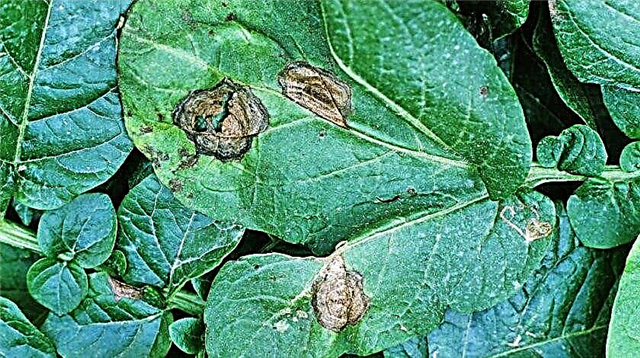
- Fusarium Symptoms: withering of the lower leaves, the acquisition of wateriness by the rest of the leaves, the formation on the plates of light green and yellowish spots. Control measures: rejection and destruction of affected plants; use (according to the instructions) of the preparations "Benefis", "Winner", "Fitosporin", "Sporobacterin". Prevention measures: chalking of the soil with chalk and dolomite flour.

- Verticillosis. Fungal disease. Symptoms: twisting seedlings in a spiral; drying and wilting of leaves from bottom to top; darkening, drying and falling of leaves and flowers. Control measures: accurate extraction and destruction of the affected bush; watering plants with fungicides - “Fundazol”, “Previkur”, “Vitaros”; processing plantings with a solution of chamomile and charcoal. Prevention measures: compliance with crop rotation rules; timely replenishment of potash and phosphorus fertilizers.
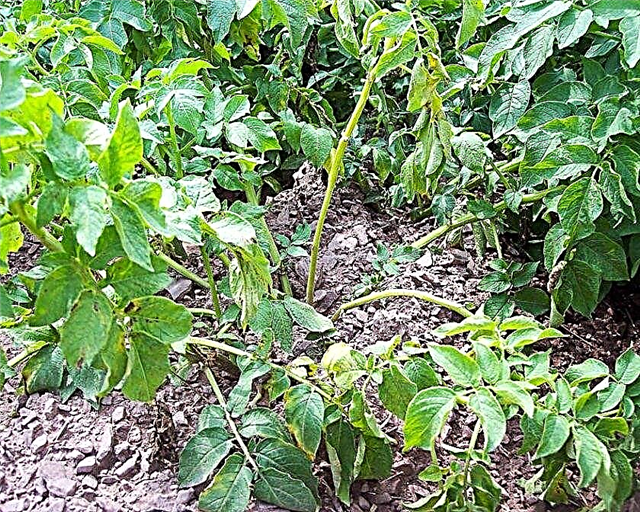
- Common scab. Infectious disease. Symptoms: destruction of the integrity of the surface of the skin of the fetus; the appearance of shapeless spots, as well as medium-sized sores and warts with a dry shell. Control measures: the use of physiologically acidic fertilizers (manganese sulfate, ammonium sulfate). Prevention measures: during planting, thorough rejection of affected potatoes, regular watering of the soil.

- Colorado beetle. Control measures: if the landing site is small - manually assemble and burn. If this is impossible to do, spray with biological agents (Agrovertin, Bikol, Colorado, Karbofos, Regent), and also treat the bushes with folk remedies - a solution of birch tar (100 g of tar for 10 liters of water).

- Golden potato cyst-forming nematode. Worm. Signs of damage: stopping the development of the plant, inhibition of its growth, weak flowering. Low productivity. Since the destruction of developed nematodes is very difficult, the main control method is prevention: treatment with insecticides, timely removal of weeds.

Harvesting and storage rules
The first harvest is done 45 days after emergence, however, in order for the potatoes to mature completely, you need to wait another 10-15 days (depending on the region of cultivation). Harvesting should be done on a dry, sunny day. This will make it possible to dry potatoes in the open air for 1.5–2 hours. During this time, solar ultraviolet rays will kill a large number of various fungal and bacterial infections.
Important! It is forbidden to cover the bottom of the potato storage with a smooth slate, batten, linoleum, cement — this can lead to mold and fungus.
After drying, it is carried out:
- Shaking potatoes off the soil adhering to them and sorting them by size, as well as for re-planting and harvesting a second crop in the current season.
- The rejection of sick and infected by harmful insects and diseases of potatoes.
- Processing sorted potatoes with antifungal compounds - Bactofit, Fitospirin, etc. are used.
- Drying processed potatoes in a shaded place (or under a canopy).
- Warehousing in special containers (this will be discussed below) and sending for storage in a special room.
A room for storing vegetables should meet certain requirements:
- The temperature regime in the room is from + 2 ° C to + 4 ° C.
- The bottom of the storage room should be covered with sand or other moisture-absorbing material.
- The repository must be pre-treated from fungal and bacterial infections, and also isolated from pests (rats, mice, slugs, etc.).
 Potato storage containers must also comply with the rules. If wooden boxes are used, then with gaps between the boards - this is necessary for proper air circulation. The capacity of one box is not more than 10-12 kg. There should be a space of 0.3 m between the storage wall and the installed drawer; from the floor to the box - 0.2 m, from the box to the ceiling - 0.6 m. When in-line installation of boxes, the interval between containers is not less than 15 cm. Fulfillment of the indicated requirements for storing the vegetable will ensure good product shelf life - about 95%.
Potato storage containers must also comply with the rules. If wooden boxes are used, then with gaps between the boards - this is necessary for proper air circulation. The capacity of one box is not more than 10-12 kg. There should be a space of 0.3 m between the storage wall and the installed drawer; from the floor to the box - 0.2 m, from the box to the ceiling - 0.6 m. When in-line installation of boxes, the interval between containers is not less than 15 cm. Fulfillment of the indicated requirements for storing the vegetable will ensure good product shelf life - about 95%.Did you know? Potatoes are grown in 125 of the 196 countries existing on Earth.
Useful tips gardeners
When cultivating the Bullfinch variety, the knowledge and use of the useful recommendations of experienced gardeners bring considerable benefit:
- On the eve of the spring digging of the site, the combined use of mineral fertilizers and organics is most effective: a mixture of 10 kg of humus, 20 g of ammonium nitrate, 20 g of potassium sulfate, 40 g of superphosphate and 450 g of dolomite flour per 1 sq. Km. m. The mixture is scattered on the ground and then embedded in the soil 20-25 cm when digging.
- It is not recommended to water after the Bullfinch has faded - the fruit is already formed, and excess moisture can cause late blight.
- In hot summers after watering, it is recommended to mulch the soil; humus, peat and mowed grass are perfect for this. The introduced mulch is then not removed, and to provide the soil with nutrients, they are embedded in the soil.
- After harvesting potatoes, the land needs improvement - planting in the autumn on the site of green manure (mustard, legumes or cereals), which are natural antiseptics and disinfectants that prevent the appearance of pathogenic fungi and protect the culture from pests.
 As you can see, the agricultural technique of cultivating a variety of potatoes Bullfinch is not particularly difficult. Strict observance of the recommended planting and care rules will ensure a plentiful harvest of this delicious potato.
As you can see, the agricultural technique of cultivating a variety of potatoes Bullfinch is not particularly difficult. Strict observance of the recommended planting and care rules will ensure a plentiful harvest of this delicious potato.








